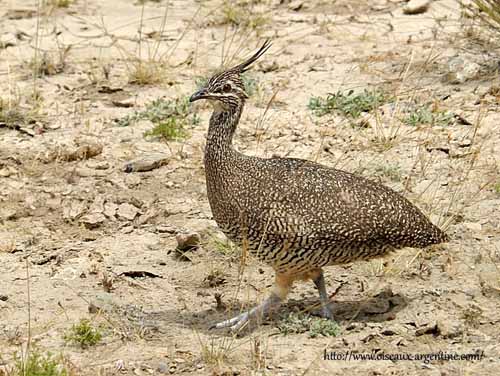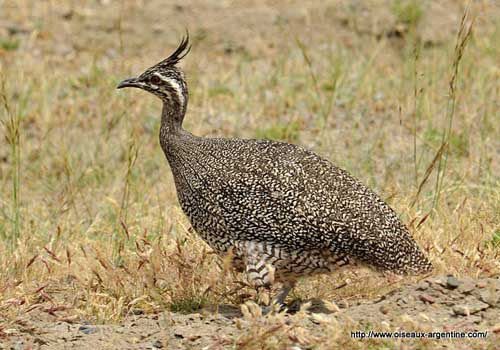
Fr: Tinamou elegant
All : Perlsteißhuhn
Esp: Martineta Común
Ital: Martinetta dal ciuffo
Nd: Kuiftinamoe
Sd: Prakttinamo
Photographers:
Philippe and Aline Wolfer
OISEAUX D'ARGENTINE
Text by Nicole Bouglouan
Sources:
HANDBOOK OF THE BIRDS OF THE WORLD vol 1 by Josep del Hoyo-Andrew Elliot-Jordi Sargatal - Lynx Edicions - ISBN: 8487334105
L’ENCYCLOPEDIE MONDIALE DES OISEAUX - Dr Christopher M. Perrins - BORDAS - ISBN: 2040185607
BirdLife International (BirdLife International)
Toronto Zoo – Same planet. Different world.
Elegant Crested-Tinamou
Eudromia elegans
Tinamiforme Order – Tinamidae Family
BIOMETRICS:
Length: 37-41 cm
Weight: 400-510 g
DESCRIPTION:
The Elegant Crested-Tinamou is a partridge-like bird which prefers running instead flying to escape predators. Unlike the Phasianidae, it lacks the hind toe and has only three toes. This is an adaptation to its usual terrestrial behaviour.
The adult has brownish cryptic plumage. Upperparts and neck are finely streaked and vermiculated blackish to brown over the white background. It has short wings and tail.
On the underparts, foreneck and breast are streaked dark, becoming finely barred on lower breast, upper belly, flanks and undertail-coverts. Belly, vent and thighs are buffy-white.
The head shows a long blackish crest on the rear crown, usually carried backwards. The head is similar to the upperparts, but we can see two conspicuous white stripes, one from above the eye, through the ear-coverts to the lower head sides, and the other is a malar stripe. Chin and throat are usually white.
The bill is blackish. The eyes are brown. Legs and three-toed feet are pale bluish.

Both sexes are similar.
The juvenile has weak, short crest. Its plumage is greyish with dark streaks above, and whitish underparts.
We can find 10 subspecies in three groups from north to south. The northern races have pale plumage (race “albida”), and intermediate and darker birds occur further south with the darkest “multiguttata”.
The race “patagonica” here displayed is the largest with a weight of 600-800 grams.
VOICE: SOUNDS BY XENO-CANTO
The Elegant Crested-Tinamou gives loud, monotonous whistles repeated several times “uit-uit-uuit…”
Some short clucks are also heard “cow cow - cow cow - cow cow”
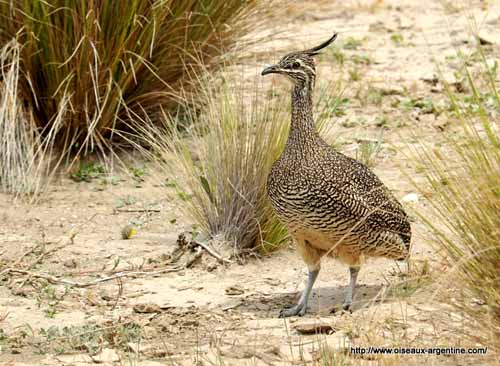
HABITAT:
The Elegant Crested-Tinamou frequents arid and semi-arid steppes, grassland, open woodland, dry savannah, bare hills with scattered patches of bushes and cultivated areas. This species can be seen from sea-level up to 2500 metres of elevation locally.
In Patagonia, it occurs mostly in sheltered valleys. In more temperate regions, it is found in sandy thorn scrub and low bushes.
RANGE:
The Elegant Crested-Tinamou is found in southern S America, from NW Argentina to S Argentina and S Chile.
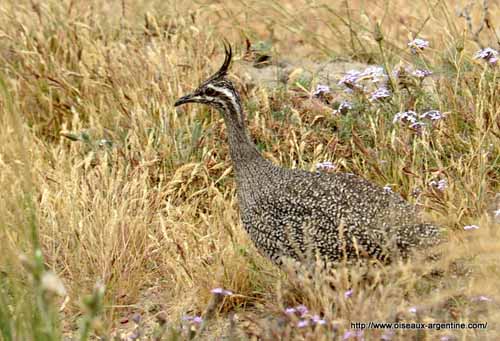
BEHAVIOUR:
The Elegant Crested-Tinamou is omnivorous. During winter, it feeds mainly on plant matter, grain, fruits, leaves and buds. During summer, it also takes several insect species. It may ingest pebbles to help in digesting the vegetal food.
These birds are very terrestrial, often seen walking or running on the ground. They are gregarious and often occur in large flocks of 50-100 adults, but usually, they forage in smaller groups. They wander widely in search of food.
They spend the night at regular roost-sites.
They usually perform regular dust-bathing in order to remove parasites from their plumage.
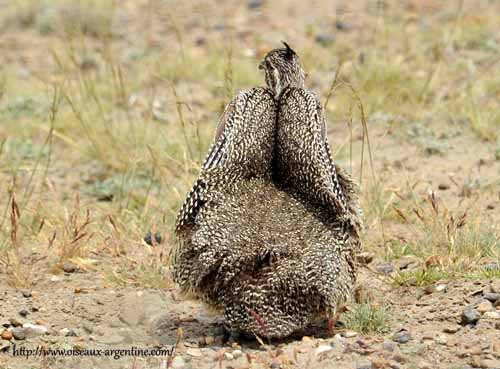
If threatened, the bird crouches down or stretches up the neck in the air. It usually avoids taking off and prefers to run off. It hides under a bush or in thick grass, taking advantage of its cryptic plumage.
Tinamous are territorial. They call within the boundaries of their area and the neighbours answer. Feet and wings are used as weapons against intruders.
Some displays are observed, as well in courting as intimidation. The bird lowers the breast to the ground with the neck stretched forwards, and fluffs up the lower back and rump feathers in order to appear larger than it is really.
They nest on the ground.
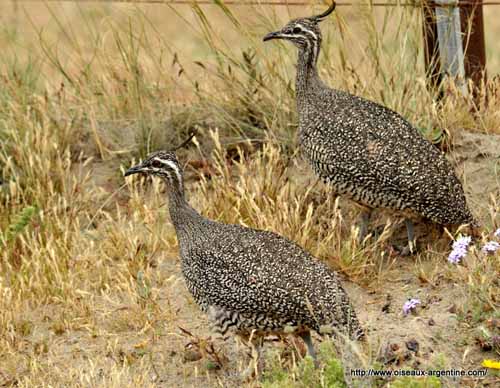
The Elegant Crested-Tinamou is probably sedentary in its range, but during winter, the groups move over large areas in search of food.
FLIGHT:
The Elegant Crested-Tinamou is a poor flier. Due to the short wings and tail, if the bird loses control at take-off, it may fly into obstacles such as branches, wires or walls, which can have fatal consequences.
They normally fly only short-distances, about 500 metres, before to land again. In steppes, they glide with interspersed flaps, recalling partridges.
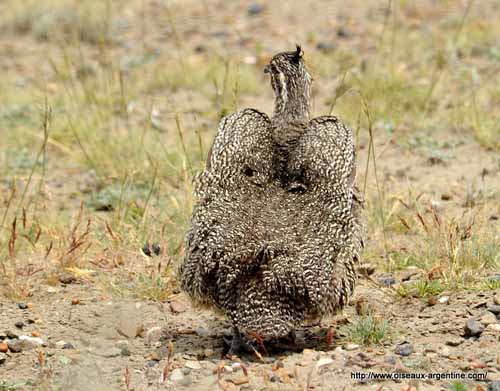
REPRODUCTION:
The breeding season occurs between June and August-November according to the range.
In this species, polyandry and/or polygyny are usual.
The Elegant Crested-Tinamou nests on the ground. The nest is made with plant material, often sheltered by vegetation.
The female lays 5-6 green eggs, shiny like porcelain. The male incubates during 20-21 days and raises the young. The chicks are precocial and leave the nest immediately after hatching.
A second or replacement brood may be produced.
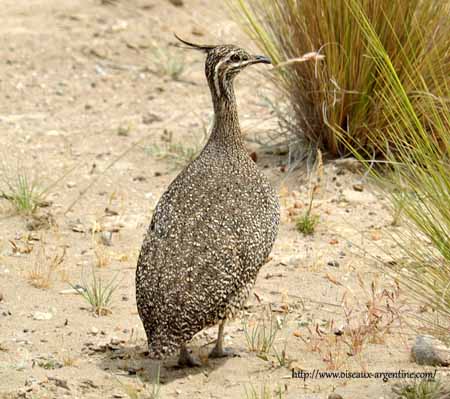
DIET:
The Elegant Crested-Tinamou feeds on plant matter such as grain, fruits, leaves and buds during winter, but in summer, it becomes mostly insectivorous, taking insects of several species by walking about on the ground.
PROTECTION / THREATS / STATUS:
The Elegant Crested-Tinamou is widespread and relatively common throughout the range. But hunting pressure and reduction of the range have involved declines in some populations.
Predation by mammals and raptors is an important threat too.
However, the species is currently evaluated as Least Concern by Birdlife International.
